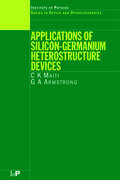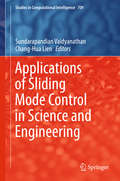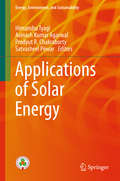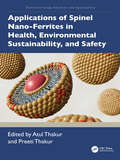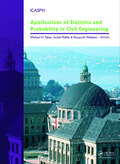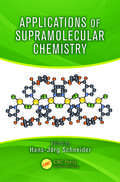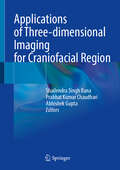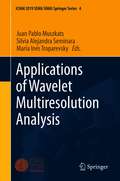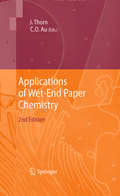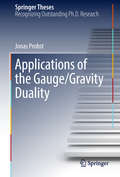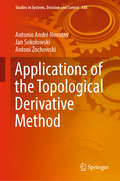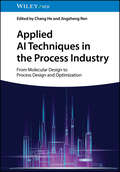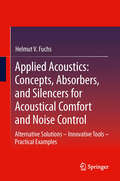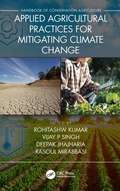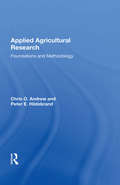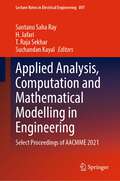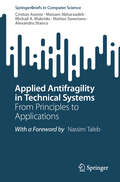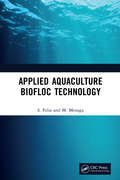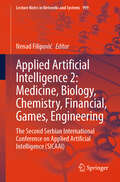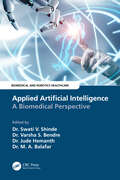- Table View
- List View
Applications of Silicon-Germanium Heterostructure Devices (Series in Optics and Optoelectronics)
by C.K Maiti G.A ArmstrongThe first book to deal with the design and optimization of transistors made from strained layers, Applications of Silicon-Germanium Heterostructure Devices combines three distinct topics-technology, device design and simulation, and applications-in a comprehensive way. Important aspects of the book include key technology issues for the growth of st
Applications of Sliding Mode Control in Science and Engineering (Studies in Computational Intelligence #709)
by Sundarapandian Vaidyanathan Chang-Hua LienGathering 20 chapters contributed by respected experts, this book reports on the latest advances in and applications of sliding mode control in science and engineering. The respective chapters address applications of sliding mode control in the broad areas of chaos theory, robotics, electrical engineering, physics, chemical engineering, memristors, mechanical engineering, environmental engineering, finance, and biology. Special emphasis has been given to papers that offer practical solutions, and which examine design and modeling involving new types of sliding mode control such as higher order sliding mode control, terminal sliding mode control, super-twisting sliding mode control, and integral sliding mode control. This book serves as a unique reference guide to sliding mode control and its recent applications for graduate students and researchers with a basic knowledge of electrical and control systems engineering.
Applications of Small Unmanned Aircraft Systems: Best Practices and Case Studies
by J. B. SharmaAdvances in high spatial resolution mapping capabilities and the new rules established by the Federal Aviation Administration in the United States for the operation of Small Unmanned Aircraft Systems (sUAS) have provided new opportunities to acquire aerial data at a lower cost and more safely versus other methods. A similar opening of the skies for sUAS applications is being allowed in countries across the world. Also, sUAS can access hazardous or inaccessible areas during disaster events and provide rapid response when needed. Applications of Small Unmanned Aircraft systems: Best Practices and Case Studies is the first book that brings together the best practices of sUAS applied to a broad range of issues in high spatial resolution mapping projects. Very few sUAS pilots have the knowledge of how the collected imagery is processed into value added mapping products that have commercial and/or academic import. Since the field of sUAS applications is just a few years old, this book covers the need for a compendium of case studies to guide the planning, data collection, and most importantly data processing and map error issues, with the range of sensors available to the user community. Written by experienced academics and professionals, this book serves as a guide on how to formulate sUAS based projects, from choice of a sUAS, flight planning for a particular application, sensors and data acquisition, data processing software, mapping software and use of the high spatial resolution maps produced for particular types of geospatial modeling. Features: Focus on sUAS based data acquisition and processing into map products Broad range of case studies by highly experienced academics Practical guidance on sUAS hardware, sensors, and software utilized Compilation of workflow insights from expert professors and professionals Relevant to academia, government, and industry Positional and thematic map accuracy, UAS curriculum development and workflow replicability issues This book would be an excellent text for upper-level undergraduate to graduate level sUAS mapping application courses. It is also invaluable as a reference for educators designing sUAS based curriculum as well as for potential sUAS users to assess the scope of mapping projects that can be done with this technology.
Applications of Solar Energy (Energy, Environment, and Sustainability)
by Avinash Kumar Agarwal Himanshu Tyagi Prodyut R. Chakraborty Satvasheel PowarThis book focuses on solar-energy-based renewable energy systems and discusses the generation of electric power using solar photovoltaics, as well as some new techniques, such as solar towers, for both residential and commercial needs. Such systems have played an important role in the move towards low-emission and sustainable energy sources. The book covers a variety of applications, such as solar water heaters, solar air heaters, solar drying, nanoparticle-based direct absorption solar systems, solar volumetric receivers, solar-based cooling systems, solar-based food processing and cooking, efficient buildings using solar energy, and energy storage for solar thermal systems. Given its breadth of coverage, the book offers a valuable resource for researchers, students, and professionals alike.
Applications of Spinel Nano-Ferrites in Health, Environmental Sustainability, and Safety (Nanotechnology Advances and Applications)
by Atul Thakur Preeti ThakurThis book presents the foundational concepts of spinel nano-ferrites, their synthesis techniques, and their cutting-edge applications in various fields. The book begins with an introduction to spinel nano-ferrites, discussing their unique properties and historical context. It then delves into various synthesis techniques, such as sol-gel methods, co-precipitation, and hydrothermal processes, highlighting the influence of these methods on the resultant structures and morphologies. The book also reviews the electrical and magnetic characteristics of spinel nano-ferrites, demonstrating their potential in electronic and magnetic devices. The role of spinel nano-ferrites in the health sector is explored in depth, detailing their use as antibacterial and antifungal agents and their innovative applications in magnetic resonance imaging (MRI), cancer detection, targeted drug delivery, and hyperthermia treatment. The chapters further examine the environmental applications of spinel nano-ferrites, including their effectiveness in pollution remediation, water purification, dye degradation, and the detection and removal of heavy metal ions and microplastics from wastewater. Toward the end, the book explores the development of gas sensors and humidity sensors using spinel nano-ferrites, as well as devices designed for human and environmental safety. This book is intended for researchers and students of nanotechnology, nanobiotechnology, healthcare professionals, and environmental scientists.Key Features: Covers foundational concepts, unique properties, and cutting-edge applications of spinel nano-ferrites Explores various synthesis methods such as sol-gel, co-precipitation, and hydrothermal processes, and their impact on structures and morphologies of spinel nano-ferrites Discusses the electrical and magnetic characteristics of spinel nano-ferrites Examines the potential of spinel nano-ferrites as antibacterial and antifungal agents, and their roles in MRI, cancer detection, and drug delivery Highlights the effectiveness of spinel nano-ferrites in pollution remediation, water purification, and dye degradation
Applications of Statistics and Probability in Civil Engineering
by M. H. Faber J. Köhler K. NishijimaUnder the pressure of harsh environmental conditions and natural hazards, large parts of the world population are struggling to maintain their livelihoods. Population growth, increasing land utilization and shrinking natural resources have led to an increasing demand of improved efficiency of existing technologies and the development of new ones. A
Applications of Superconducting Fault Current Limiters in Power Electronics-Dominated Power Systems
by Lei Chen Hongkun Chen Li Ren Yuejin TangThe book discusses superconducting fault current limiters and their applications in power systems, exploring the principles, simulations and engineering practices, but focusing on systematic applications in traditional and renewable power systems. It provides in-depth studies on a number of major topics such as architecture of superconducting fault current limiter, device design, parameter optimization, prototype testing, co-ordination control and performance evaluation. It also describes multiple application cases of superconducting fault current limiters, which are applied in high voltage direct current transmission systems, active distribution networks, and micro-grids. Offering a comprehensive and systematic overview of practical issues, the book is intended for readers wanting to learn practical approaches for developing superconducting fault current limiters. It also appeals to researchers, engineers and graduate students in various fields, including high-temperature superconducting materials, power system transient stability, and control science and engineering.
Applications of Supramolecular Chemistry
by Hans-Jörg SchneiderApplications of Supramolecular Chemistry introduces the use of non-covalent interactions and molecular recognition for many fields. Applications include the analysis of technically, medically, and environmentally important chemical compounds, their separation, purification and removal, and the design of new materials, including supramolecular elect
Applications of Three-dimensional Imaging for Craniofacial Region
by Abhishek Gupta Prabhat Kumar Chaudhari Shailendra Singh RanaThe book provides sound knowledge of 3D imaging of dentofacial craniofacial region. It guides the students and faculty for understanding the dentofacial craniofacial region in depth. It incorporates the latest techniques, frameworks and technologies in the imaging area of oral health. The book emphasizes on the dentofacial and craniofacial region and thus fills the gap in the medical imaging literature. The development in this book is not only on the imaging techniques but also emphasis will be on the three-dimensional (3D) frameworks to deal the patients for their diagnosis and treatment planning. The chapters of this book are designed in such a way that the readers may get the complete package of the exploration of the imaging clinical applications of craniofacial areas. This book will be helpful not only for the students and faculty but also for the researchers working in the relevant areas.This book will provide easy, simple way but the most authentic material to learn the craniofacial region imaging. In this manual we will incorporates authentic, internationally accepted terms and definition. To make it interesting and simple, our approach is to incorporate the material in systematic manner in a simple and easy way by incorporating maximum illustrations and flowcharts. This book provides sound knowledge of various advanced technologies for dentist imaging. This book will highlights the importance and explore the current research in the dentofacial and craniofacial areas.
Applications of Wavelet Multiresolution Analysis (SEMA SIMAI Springer Series #4)
by Juan Pablo Muszkats Silvia Alejandra Seminara María Inés TroparevskyThis work results from a selection of the contributions presented in the mini symposium “Applications of Multiresolution Analysis with “Wavelets”, presented at the ICIAM 19, the International Congress on Industrial and Applied Mathematics held at Valencia, Spain, in July 2019. The presented developments and applications cover different areas, including filtering, signal analysis for damage detection, time series analysis, solutions to boundary value problems and fractional calculus. This bunch of examples highlights the importance of multiresolution analysis to face problems in several and varied disciplines. The book is addressed to researchers in the field.
Applications of Wet-End Paper Chemistry
by Ian Thorn Che On Au"Applications of Wet-end Paper Chemistry" bridges the gap between the theory and practice of wet-end paper chemistry by explaining how particular chemicals are chosen and put to use in real situations. A number of international experts in the field present recent contributions on the optimum use of chemicals in papermaking. Major inroads have taken place since the first edition of this title was published in 1995. This new edition of "Applications of Wet-end Paper Chemistry" will reflect the changing type and use of chemicals used in papermaking in the 21st century. Chemists and chemical engineers across the paper and pulp making industry, as well as in research and academic institutes will find this book of enormous practical value.
Applications of the Gauge/Gravity Duality (Springer Theses)
by Jonas ProbstMany open questions in Theoretical Physics pertain to strongly interacting quantum systems such as the quark-gluon plasma (QGP) produced in heavy-ion collisions or the strange-metal phase observed in many high-temperature superconductors. These systems are notoriously difficult to study using traditional methods such as perturbation theory, but the gauge/gravity duality offers a successful alternative approach, which maps strongly interacting quantum gauge theories to computationally tractable, classical gravity theories. This book begins with a pedagogical introduction to how the duality can be used to extract transport properties of quantum systems from their gravity dual. It then presents new results on hydrodynamic transport in strongly interacting quantum fluids, providing strong evidence that the Haack-Yarom identity between second-order transport coefficients holds for all fluids with a classical gravity dual and may be a universal feature of all strongly coupled quantum fluids such as the QGP. Newly derived Kubo formulae, expressing transport coefficients in terms of quantum correlators, hold independently of the duality. Lastly, the book discusses new results on magnetic impurities in strongly correlated metals, including the first dual gravity description of an inter-impurity coupling, crucial for the quantum criticality underlying the strange-metal phase.
Applications of the Laser: The Introduction Of Laser Applications Into Biology And Medicine
by Leon GoldmanThe laser's range of application is extraordinary. Arthur Schawlow says, "What instrument can shuck a bucket of oysters, correct typing errors, fuse atoms, lay a straight line for a garden bed, repair detached retinas, and drill holes in dia monds?"O The laser's specifically biomedical uses cover a similarly broad and interesting spectrum. In this book, I have endeavored to convey some of the fas cination that the laser has long held for me. It is my hope that both clinicians and researchers in the various medical and surgical specialties will find the book a use ful introduction. Biologists, particularly molecular biologists, should also find a great deal of relevant information herein. This volume's distinguished contributors provide admirably lucid discussions of laser principles, instrumentation, and current practice in their respective special ties. Safety, design, capabilities, and costs of various lasers are also reviewed. We have aimed to create a practical text that is comprehensive but not exhaustive. Our emphasis on the practical, rather than the esoteric, is dictated not only by the short history of biomedical laser use, but by the extent of the community to which this information will appeal.
Applications of the Topological Derivative Method (Studies in Systems, Decision and Control #188)
by Antonio André Novotny Jan Sokołowski Antoni ŻochowskiThe book presents new results and applications of the topological derivative method in control theory, topology optimization and inverse problems. It also introduces the theory in singularly perturbed geometrical domains using selected examples. Recognized as a robust numerical technique in engineering applications, such as topology optimization, inverse problems, imaging processing, multi-scale material design and mechanical modeling including damage and fracture evolution phenomena, the topological derivative method is based on the asymptotic approximations of solutions to elliptic boundary value problems combined with mathematical programming tools. The book presents the first order topology design algorithm and its applications in topology optimization, and introduces the second order Newton-type reconstruction algorithm based on higher order topological derivatives for solving inverse reconstruction problems. It is intended for researchers and students in applied mathematics and computational mechanics interested in the mathematical aspects of the topological derivative method as well as its applications in computational mechanics.
Applications of the Universal Thermal Climate Index UTCI in Biometeorology: Latest Developments and Case Studies (Biometeorology #4)
by Eduardo L. KrügerThis book introduces the UTCI (Universal Thermal Climate Index) and summarizes progress in this area. The UTCI was developed as part of the European COST Action Program and first announced to the scientific community in 2009. Since then, a decade has followed of applicability tests and research results, as well as knowledge gained from applying the UTCI in human adaptation and thermal perception. These findings are of interest to researchers in the interdisciplinary areas of biometeorology, climatology and urban planning. The book summarizes this progress, discussing the limitations found and provides pointers to future developments. It also discusses UTCI applications in the areas of human biometeorology and urban planning including possibilities of using UTCI and similar indices in climate-responsive urban planning. The book’s message is illustrated with many case studies from the real world.Chapter 10 is available open access under a Creative Commons Attribution 4.0 International License via link.springer.com.
Applied AI Techniques in the Process Industry: From Molecular Design to Process Design and Optimization
by Jingzheng Ren Chang HeThorough discussion of data-driven and first principles models for energy-relevant systems and processes, approached through various in-depth case studies Applied AI Techniques in the Process Industry identifies and categorizes the various hybrid models available that integrate data-driven models for energy-relevant systems and processes with different forms of process knowledge and domain expertise. State-of-the-art techniques such as reduced-order modeling, sparse identification, and physics-informed neural networks are comprehensively summarized, along with their benefits, such as improved interpretability and predictive power. Numerous in-depth case studies regarding the covered models and methods for data-driven modeling, process optimization, and machine learning are presented, from screening high-performance ionic liquids and AI-assisted drug design to designing heat exchangers with physics-informed deep learning. Edited by two highly qualified academics and contributed to by a number of leading experts in the field, Applied AI Techniques in the Process Industry includes information on: Integration of observed data and reaction mechanisms in deep learning for designing sustainable glycolic acidMachine learning-aided rational screening of task-specific ionic liquids and AI for property modeling and solvent tailoringIntegration of incomplete prior knowledge into data-driven inferential sensor models under the variational Bayesian frameworkAI-aided high-throughput screening, optimistic design of MOF materials for adsorptive gas separation, and reduced-order modeling and optimization of cooling tower systemsSurrogate modeling for accelerating optimization of complex systems in chemical engineering Applied AI Techniques in the Process Industry is an essential reference on the subject for process, chemical, and pharmaceutical engineers seeking to improve physical interpretability in data-driven models to enable usage that scales with a system and reduce inaccuracies and mismatch issues.
Applied Acoustics: Alternative Solutions - Innovative Tools - Practical Examples
by Helmut V. FuchsThe author gives a comprehensive overview of materials and components for noise control and acoustical comfort. Sound absorbers must meet acoustical and architectural requirements, which fibrous or porous material alone can meet. Basics and applications are demonstrated, with representative examples for spatial acoustics, free-field test facilities and canal linings. Acoustic engineers and construction professionals will find some new basic concepts and tools for developments in order to improve acoustical comfort. Interference absorbers, active resonators and micro-perforated absorbers of different materials and designs complete the list of applications.
Applied Agricultural Practices for Mitigating Climate Change [Volume 2]
by Vijay P. Singh Rohitashw Kumar Deepak Jhajharia Rasoul MirabbasiConservation agriculture is a sustainable production model that not only optimizes crop yields, but also reaps economic and environmental benefits as well. The adoption of successful conservation agriculture methods has resulted in energy savings, higher organic matter content and biotic activity in soil, increased crop-water availability and thus resilience to drought, improved recharge of aquifers, less erosion, and reduced impacts from the weather associated with climate change in general. Applied Agricultural Practices for Mitigating Climate Change examines several important aspects of crop production, such as the use of microorganisms and biofertilizers as well as GIS and Remote Sensing applications. It presents the latest techniques in crop modeling, best practices for irrigation under water deficit conditions, and other approaches for sustainable conservation agriculture that consider the environmental effects of climate change. Features: Examines the effects of climate change on agriculture and the related strategies for mitigation through practical, real-world examples Explores innovative on-farm technology options to increase system efficiency resulting in improved water usage Presents examples of precision farming using climate-resilient technologies
Applied Agricultural Research: Foundations And Methodology
by Chris O AndrewThe desire to resolve problems through pragmatic observation, systematic evaluation, and coordinated action persists with each new generation of researchers. A timeless task that bears individual, social, and often cultural characteristics, problem resolution is essentially an experiential process. Routine and methodology can enhance both its proce
Applied Analysis, Computation and Mathematical Modelling in Engineering: Select Proceedings of AACMME 2021 (Lecture Notes in Electrical Engineering #897)
by Santanu Saha Ray H. Jafari T. Raja Sekhar Suchandan KayalThis book is a compendium of the proceedings of the International Conference on Applied Analysis, Computation, and Mathematical Modelling in Engineering (AACMME-2021). The book covers a variety of applications such as mechanical, acoustical, physical, electrical, bio-mathematical, and computational fluid dynamics. Since mathematical modeling necessitates a wide range of skills and methods, the book concentrates on techniques that will be of specific interest to engineers, scientists, and those who work with discrete and continuous systems models. This book guides students, researchers, and professionals through the new approaches, the powerful tools for quickly mastering the most popular mathematical and computational models used in engineering and science. These new approaches enable readers to not only systematically create effective models, but also extend these models to any macroscopic physical structure.
Applied Antifragility in Technical Systems: From Principles to Applications (SpringerBriefs in Computer Science)
by Matteo Saveriano Cristian Axenie Meisam Akbarzadeh Michail A. Makridis Alexandru StancuThe book purpose is to build a foundational knowledge base by applying antifragile system design, analysis, and development in technical systems, with a focus on traffic engineering, robotics, and control engineering. The authors are interested in formalizing principles and an apparatus that turns the basic concept of antifragility into a tool for designing and building closed-loop technical systems that behave beyond robust in the face of uncertainty. As coined in the book of Nassim Taleb, antifragility is a property of a system to gain from uncertainty, randomness, and volatility, opposite to what fragility would incur. An antifragile system’s response to external perturbations is beyond robust, such that small stressors can strengthen the future response of the system by adding a strong anticipation component. The work of the Applied Antifragility Group in traffic control and robotics, led by the authors, provides a good overview on the current research status.
Applied Aquaculture Biofloc Technology
by S. Felix M. MenagaThe intent of this book is to provide a detailed and specific set of guidelines for both aquapreneurs and researchers related to the application of Biofloc Technology in aquaculture. This book discusses key issues related to both adoption and practices for aquaculture businesses, how to monitor and assess quality and quantity of biofloc, and how to manage the microbial composition and sludge reduction risk in the fish and shrimp culture. The book works through the specific application of disease management and feed management tools for aquaculture from the perspective of this technology. Particular attention is paid on comparing the prototypes of floc development and evaluation on its efficacy in aquaculture. Note: T&F does not sell or distribute the hardback in India, Pakistan, Nepal, Bhutan, Bangladesh and Sri Lanka.
Applied Artificial Intelligence 2: The Second Serbian International Conference on Applied Artificial Intelligence (SICAAI) (Lecture Notes in Networks and Systems #999)
by Nenad FilipovićThe book Applied Artificial Intelligence 2: Medicine, Biology, Chemistry, Financial, Games, Engineering is providing exceptional chapters of the state-of-the-art research knowledge and results on the innovative theories, methodology and applications of artificial intelligence and its sub-domain like deep learning, machine learning in different areas such as medicine, economy, education, law, smart city, government, industry etc. Innovative research ideas on how to solve problems using artificial intelligence, both in R&D and real-time applications are presented. Chapters describe the advanced prototypes, systems, methodologies, tools and techniques and general survey papers, which indicate future directions. These Chapters are extended papers from the Second Serbian International Conference on Applied Artificial Intelligence (SICAAI), which was held in Kragujevac, Serbia, on May 19-20, 2023
Applied Artificial Intelligence 4: The Third Serbian International Conference on Applied Artificial Intelligence (SICAAI) (Lecture Notes in Networks and Systems #1446)
by Nenad FilipovićThe book covers the state-of-the-art research knowledge and results on the innovative theories, methodology and applications of artificial intelligence and its sub-domain like deep learning in different areas such as medicine, economy, education, law, smart city, government, industry etc. Moreover, the book aims to provide a platform for researchers and practitioners for both academia and industry to share the information about cutting-edge developments in the field of artificial intelligence. The chapters in this book integrated approach toward global exchange of information on technological advances, scientific innovations and the effectiveness of various regulatory programs toward AI application in medicine, biology, chemistry, financial, games, law and engineering. Real examples from academia and industry give beyond state of the art for application of AI in different areas. These chapters are extended papers from the Third Serbian International Conference on Applied Artificial Intelligence (SICAAI), which was held in Kragujevac, Serbia, on May 23–24, 2024.
Applied Artificial Intelligence: A Biomedical Perspective (Biomedical and Robotics Healthcare)
by Jude Hemanth Swati V. Shinde Varsha S. Bendre M. A. BalafarThis book explores the advancements and future challenges in biomedical application developments using breakthrough technologies like Artificial Intelligence (AI), Internet of Things (IoT), and Signal Processing. It will also contribute to biosensors and secure systems,and related research. Applied Artificial Intelligence: A Biomedical Perspective begins by detailing recent trends and challenges of applied artificial intelligence in biomedical systems.Part I of the book presents the technological background of the book in terms of applied artificial intelligence in the biomedical domain. Part II demonstrates the recent advancements in automated medical image analysis that have opened ample research opportunities in the applications of deep learning to different diseases. Part III focuses on the use of cyberphysical systems that facilitates computing anywhere by using medical IoT and biosensors and the numerous applications of this technology in the healthcare domain. Part IV describes the different signal processing applications in the healthcare domain. It also includes the prediction of some human diseases based on the inputs in signal format. Part V highlights the scope and applications of biosensors and security aspects of biomedical images.The book will be beneficial to the researchers, industry persons, faculty, and students working in biomedical applications of computer science and electronics engineering. It will also be a useful resource for teaching courses like AI/ML, medical IoT, signal processing, biomedical engineering, and medical image analysis.
